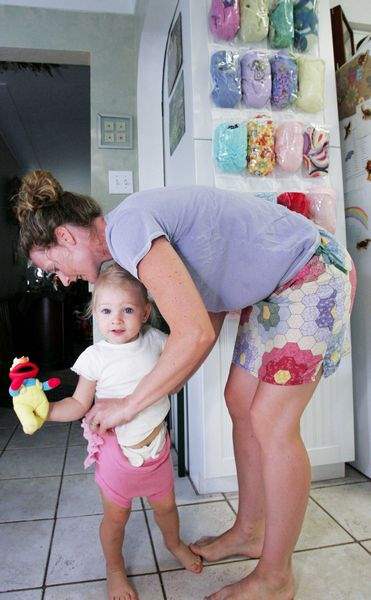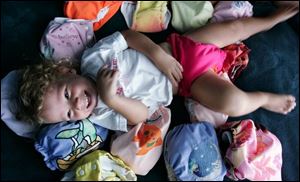
The diaper decision: Disposables or cloth? Both have their supporters
9/23/2007
Shelly De Meo checks her daughter Sage's diaper cover. Behind are the various diaper covers the family has for Sage.
Jetta Fraser/The Toledo Blade / The Blade/Jetta Fraser
Buy This Image

Sage Colon, 2, is comfortable surrounded by some of her cloth diapers and diaper covers.
Cloth diapers.
Yuck.
Shelly De Meo is used to reactions like that when she tells people she diapers her 18-month-old daughter, Sage, in cloth.
The biggest thing I hear from people is eeoow, admitted the Toledo mom, one of an estimated 5 to 10 percent of parents who use cloth diapers for their infants and toddlers, either exclusively or in combination with disposables.
But what the cloth camp lacks in numbers, they make up for in fervor, pointing out that today s cloth diapers are much improved from the plain, ill-fitting wads that our mothers and grandmothers and their mothers and grandmothers pinned around their babies. They say cloth diapers are cute, economical, and easy to use, and they contend cloth is healthier for their children and more environmentally friendly than the disposables that have come to dominate the diaper market since they were introduced in 1961.
(The other side begs to differ, of course. And an Ohio State University Extension study done in 1990 by Joyce A. Smith and Norma Pitts, both now retired, concluded: No evidence exists that one method is clearly superior in terms of impact on health, environment, and economic issues. )
If kids could vote on the choice, 27-month-old Sage Colon apparently would cast hers for cloth.

Shelly De Meo checks her daughter Sage's diaper cover. Behind are the various diaper covers the family has for Sage.
She s very vocal about what diaper she wants to use, said her mother, Julie Colon of Perrysburg. It seems that one day when Sage was at the babysitter s house, the sitter accidentally used a disposable diaper when she changed the toddler. Sage was hollering at her and yelling no, no, ripped the diaper off and threw it at her, and went over and got one of her cloth diapers, Mrs. Colon said. Nothing speaks better than an angry toddler.
But in speaking with some other parents about cloth diapers, Mrs. Colon encounters the same eeoow that Mrs. De Meo does.
Usually they re like, that s disgusting, or why would you do that? The quickest way to stop those questions is to show them whatever she has on at the time. They re cute, they re different colors, some are embroidered. Or I tell them, feel how nice and soft this is. They re expecting to see the pins and the rubber pants.
Today s cloth diaper choices include styles that are contoured, fitted with elastic around the legs, and All-in-One s that don t require a cover. The old rubber pants have been replaced with water-resistant covers made of nylon, wool, or polyurethane laminate (referred to as PUL), a polyester fabric that s laminated on one side. Covers can be a pull-on pant or a wrap that is secured with snaps or Velcro.
It can seem a little overwhelming to start, acknowledged Mrs. De Meo, a massage therapist. Both she and Mrs. Colon said they had tried and then given up on cloth diapers at one time because they didn t have enough information and didn t know anyone they could turn to for answers.
Now that they know more, they want to help other parents who might be using disposables because they aren t aware of today s cloth diaper options or don t know enough about using them.
They ve established an e-mail address that people can use to send them questions about cloth diapering (notyourgrannysdiapers@yahoo.com), and in July they offered the first of what they plan to be periodic classes called Cloth Diapering Uncovered. The fee is $12 per couple, and registration is through Kneading Time (www.ktholistictherapy.com), Mrs. DeMeo s holistic therapy center at 5702 West Alexis Rd.
Six moms and one dad attended the first session. The next one is scheduled for 6:30 p.m. Thursday. Call 419-885-8780 or go online to register.
Mrs. De Meo and Mrs. Colon stressed that they don t sell diapers and are not affiliated with any diaper company or store. We do not promote any particular brands other than based on what brands work for our kids, added Mrs. Colon, a teacher at DeVeaux Junior High School. We do not get free or discounted diapers for personal use from anyone.
They re believers, pure and simple.
Two market forces work against cloth diapers, they say. One is that the high-quality, updated diapers and covers aren t readily available in northwest Ohio stores. Tree City Diapers in Ann Arbor is a popular resource for local cloth-diaper buyers, as well as Internet stores and online sites where parents buy, sell, and trade diapers.
The second factor is the near-extinction of diaper services those businesses that come to the house, drop off a supply of clean diapers, and take away the dirty ones.
There are less than 100 diaper services that I know of in the country, said John A. Shiffert, executive director of the National Association of Diaper Services in suburban Philadelphia. There were probably 1,000-plus at one time.
The association s Web site (diapernet.org) has a list of diaper services, both members and nonmembers. It lists one in Ohio Diaper Eze in Canton, where an answering machine picked up a call on a recent weekday morning. The site lists two diaper services in Michigan: Health Care Diaper Service in Jenisen ( We re no longer doing that, said a woman who answered the phone) and Diapers Unlimited DyDee Service (www.diapersunlt.com) in Kalamazoo.
At its peak, Diapers Unlimited had 12,000 customers, three plants that did laundry, and two sales offices, recalled Mary Hilton, who owned the company for 45 years and now works there part-time. When the cloth diaper business went bust, the family company died, she said in a phone interview, and she sold it to the current owner, who has stayed afloat by diversifying into other types of laundry.
Both she and Mr. Shiffert of the national association said that diaper services boomed in the late 1980s and early 1990s after the industry commissioned studies on the environmental impact of disposable diapers. We grew exponentially until we caught the attention of the disposable diaper people who hadn t paid much attention to diaper services. They commissioned their own studies, Mr. Shiffert said.
While cloth proponents made their environmental case (and still do) by pointing to the use of raw materials to produce disposable diapers, and the billions of dirty diapers piling up in landfills, the other side has fought back by citing the water and energy required to wash and dry cloth diapers, and fuel used by commercial diaper services.
Randy Johnson, the current owner of Diapers Unlimited DyDee Service, said in the last 4-5 weeks there seems to have been a bump in the number of calls from people with questions about diaper service, but that many young parents simply don t know what cloth diapers are. Are they real diapers? some have asked him and by that, they mean disposables.
It s not as hard as people make it seem to be, asserted Erin Leiser of Oregon. She and her husband, Philip, use cloth diapers for their 14-month-old daughter, Amelia.
For me it doesn t even add a whole other load [of laundry] a week, Mrs. Leiser said.
Though she feels strongly that cloth is a better choice for Amelia, the family budget, and the environment she admitted that my mom and dad thought I was nuts in making that choice, and my sitter doesn t do cloth. She says she did it with her girls. She s done with it. From what I can gather, she doesn t want the whole rinsing-them-out part.
To Dr. Sean Rae, a pediatrician in Sylvania, and Monica Taylor, manager of the Preparation for Parenthood program at Toledo and Flower hospitals, there s no one best diaper.
Dr. Rae said disposable diapers seem to have the edge in two areas: fewer diaper rashes and better containment. But he added that, I m not slamming the cloth diaper. What it comes down to is personal preference.
More questions about cloth diapers are coming up in parenting classes, according to Mrs. Taylor, a registered nurse, who pointed out that it doesn t have to be an either-or choice.
What kind of diaper a baby wears could depend on who is doing the changing someone who is committed to cloth or a babysitter or other family member who prefers disposables. It also could depend on the situation cloth at home, disposables when you re traveling. Or one type for daytime and another for overnight.
You really need to look at all the pros and cons of both, she concluded. Either way, Mrs. Taylor advised, make sure the diaper is changed frequently enough to keep the baby s skin healthy.
Contact Ann Weber at: aweber@theblade.com or 419-724-6126.